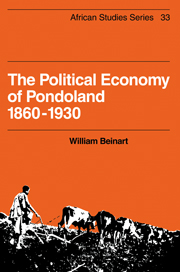Book contents
- Frontmatter
- Contents
- List of maps
- Preface
- Abbreviations
- Introduction
- 1 The political economy of Pondoland in the nineteenth century
- 2 Crops, cattle and the origins of labour migrancy, 1894–1911
- 3 Rural production and the South African state, 1911–1930
- 4 Chiefs and headmen in Pondoland, 1905–1930
- 5 Rural differentiation, alliance and conflict, 1910–1930
- Postscript
- Tables
- Notes
- Select bibliography
- Index
- BOOKS IN THIS SERIES
1 - The political economy of Pondoland in the nineteenth century
Published online by Cambridge University Press: 26 February 2010
- Frontmatter
- Contents
- List of maps
- Preface
- Abbreviations
- Introduction
- 1 The political economy of Pondoland in the nineteenth century
- 2 Crops, cattle and the origins of labour migrancy, 1894–1911
- 3 Rural production and the South African state, 1911–1930
- 4 Chiefs and headmen in Pondoland, 1905–1930
- 5 Rural differentiation, alliance and conflict, 1910–1930
- Postscript
- Tables
- Notes
- Select bibliography
- Index
- BOOKS IN THIS SERIES
Summary
The material basis of the Mpondo chiefdom, c. 1820–60
Although it is clear that the Mpondo chiefdom had been located as a recognisable entity on the eastern side of the Mzimvubu river for at least a couple of centuries, and probably longer, before the Mfecane, sources on the area are too sparse to provide a picture of the society in this period. The few reports and traditions that have survived affirm that the Mpondo resembled other ‘Nguni’ peoples who inhabited the whole of the east coast of South Africa. Each Nguni polity had its own distinctive character: linguistically and culturally, the Mpondo fell somewhere between the Xhosa, Thembu, Bomvana and Mpondomise to the south-west, later dubbed the ‘Cape Nguni’, and the many small units in pre-Mfecane Natal, whose way of life has been reconstructed by Bryant from traditions. Yet all shared basic features of social organisation and material culture which distinguished them from other African societies in southern Africa. They had been forged in a relatively similar environment–the undulating coastal strip, with a high rainfall and broken by many rivers and streams, between the Drakensberg and the sea. Settlement was usually in dispersed home-steads, rather than the concentrated villages of the Sotho and Tswana; cattle played a central role in subsistence and social relationships; land was cultivated by means of wooden digging sticks or, more rarely, metal hoes. A similar pattern of kinship, lineage and clan organisation, patrilineal succession and exogamous marriage, in which cattle were used as bridewealth, recurred throughout.
- Type
- Chapter
- Information
- The Political Economy of Pondoland 1860–1930 , pp. 9 - 41Publisher: Cambridge University PressPrint publication year: 1982



